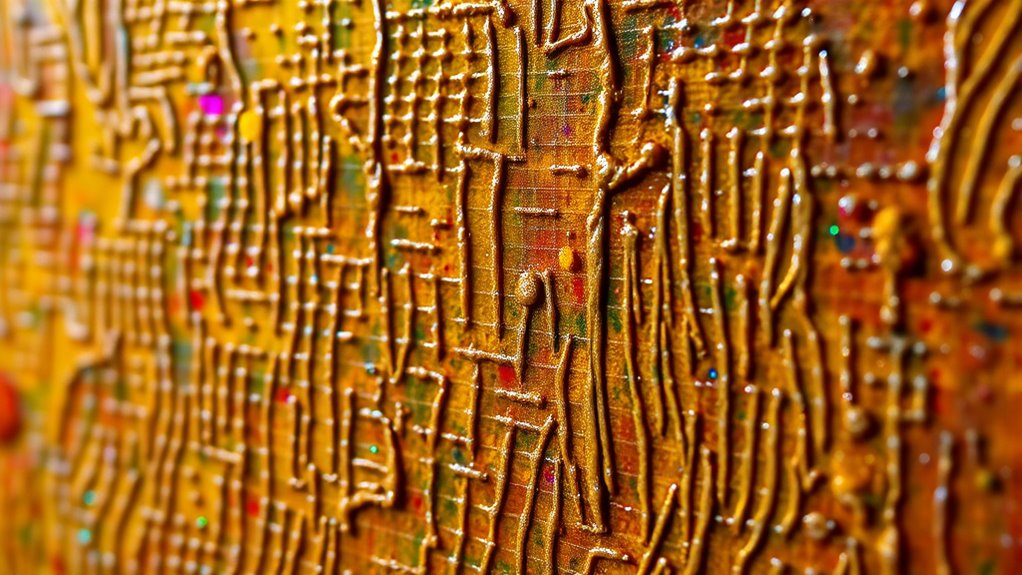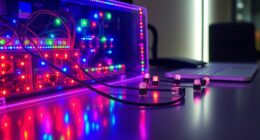Spectral fingerprinting uses light interactions with pigments to verify a painting’s authenticity. By analyzing how materials absorb, fluoresce, and reflect specific wavelengths, you can identify unique material signatures that confirm whether an artwork is genuine or a forgery. Authentic works reveal consistent spectral patterns over time, while forgeries often show modern or synthetic materials. To understand how this sophisticated technique can protect and authenticate art, keep exploring the fascinating details behind spectral analysis.
Key Takeaways
- Spectral fingerprinting identifies unique pigment signatures by analyzing how light interacts with materials in paintings.
- Non-invasive light analysis detects aging signs and material consistency to verify artwork authenticity.
- Differences in spectral signatures distinguish genuine pigments from modern forgeries or synthetic substitutes.
- Combining spectral data with other methods enhances accuracy in authenticating artworks.
- Advanced light analysis techniques enable rapid, detailed, and preservation-friendly examination of paintings.
Understanding Spectral Fingerprinting in Art Authentication

Spectral fingerprinting is a powerful tool used to verify the authenticity of artworks by analyzing their unique material signatures. This technique helps you assess color accuracy, ensuring that the pigments used align with historical periods or artist specifications. It also provides insights into pigment stability, revealing how pigments have aged or reacted over time. By examining how light interacts with different materials, you can identify genuine artworks and detect forgeries. Spectral fingerprinting captures the distinct absorption and reflection patterns of pigments, giving you a detailed material profile. This information is essential for conservation efforts and authentication processes, allowing you to make informed decisions based on the artwork’s unique spectral signature. Additionally, understanding the trustworthiness of analytical methods like spectral fingerprinting is crucial for maintaining confidence in authentication results. Ultimately, it offers a non-invasive, precise way to verify authenticity while preserving the artwork’s integrity.
The Science Behind Light Analysis of Pigments
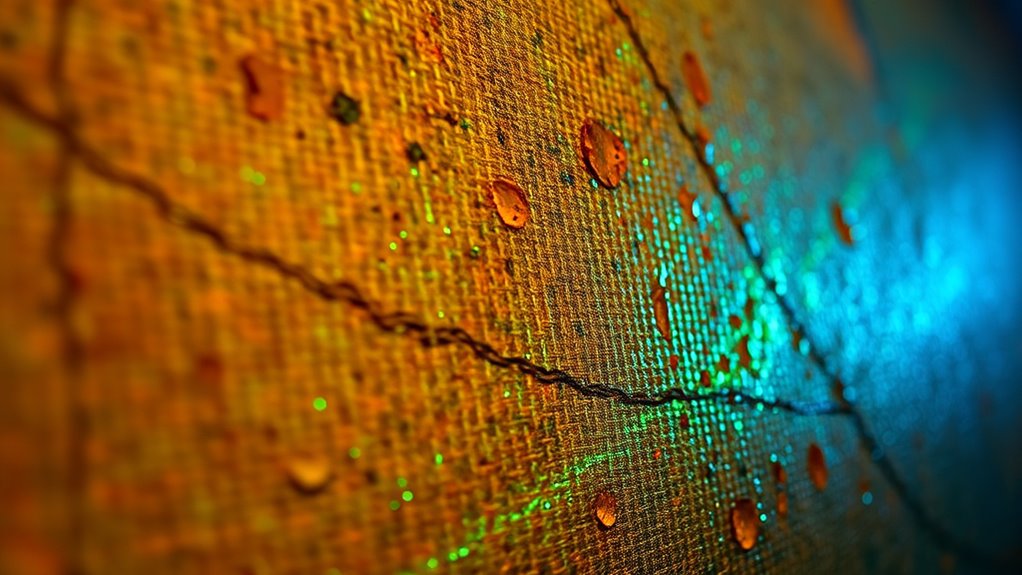
Understanding how light interacts with pigments is essential to grasping spectral analysis. When light hits a pigment, some wavelengths are absorbed, a process known as light absorption, which reveals a pigment’s unique properties. The absorbed energy can also cause pigment fluorescence, where the pigment emits light at a different wavelength. This fluorescence helps identify specific materials, as different pigments fluoresce distinctively under certain light sources. By analyzing these interactions, scientists can determine the composition and age of pigments in a painting. Light absorption and fluorescence provide precise fingerprints that distinguish authentic artworks from forgeries. Recognizing how spectral signatures are used in analysis enhances the accuracy of authentication methods. This scientific approach offers reliable insights into a painting’s materials, enabling experts to authenticate works based on their spectral signatures.
How Spectral Signatures Differ for Authentic and Forged Works
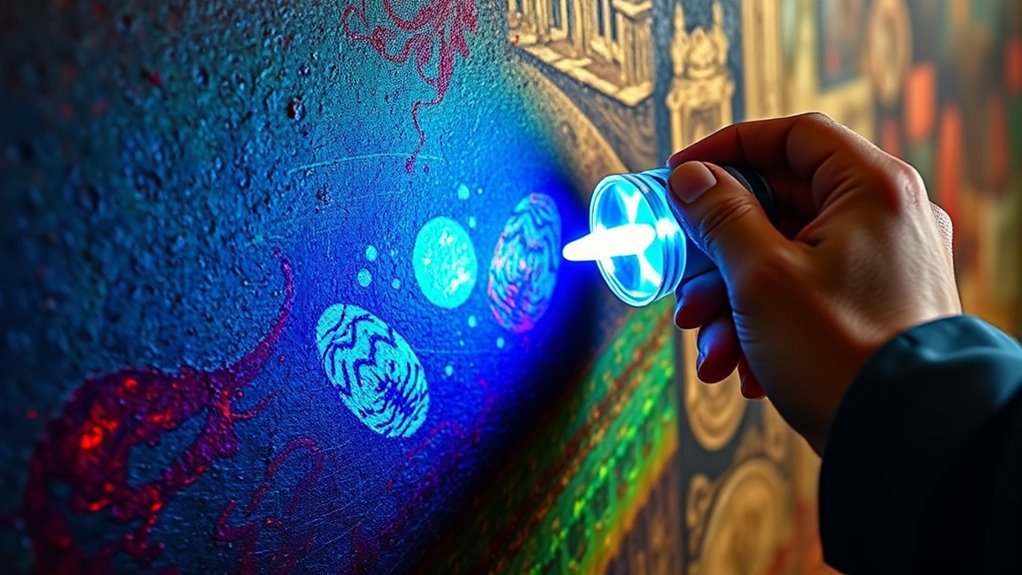
You can often spot differences in spectral signatures by examining material composition and pigment variations. Forged works may use modern or inconsistent materials, creating distinct spectral patterns from authentic pieces. Additionally, signs of aging and degradation can help you identify discrepancies in the spectral data. To enhance detection, utilizing free crypto opportunities like promotional offers and social media giveaways can fund access to advanced spectral analysis tools.
Material Composition Differences
Authentic artworks are created using specific materials whose composition remains consistent over time, producing distinctive spectral signatures. When analyzing these signatures, you can detect subtle differences in material composition that influence how light interacts with the paint. For example, authentic paintings often involve precise paint mixing techniques, resulting in predictable spectral responses aligned with known pigment properties. Forged works, however, may use modern or synthetic materials that alter these signatures, making them stand out. Additionally, the way colors are perceived can be affected by the underlying material layers, which differ in authenticity. By comparing spectral data, you can identify inconsistencies in pigment composition and application methods, revealing whether a work’s material makeup matches that of authentic pieces or suggests a forgery. Material analysis techniques play a crucial role in ensuring the accuracy of spectral fingerprinting in art authentication.
Pigment Spectral Variations
Spectral signatures of pigments reveal clear differences between authentic artworks and forgeries. Authentic paintings typically show consistent spectral patterns, while forgeries often display irregularities due to modern or synthetic pigments. Variations in pigment spectral signatures can be identified through spectral resolution, highlighting subtle differences. To understand these variations, it is essential to consider the spectral resolution of the pigments, which can uncover detailed information about their composition and manufacturing process. Authentic pigments maintain consistent color signatures over time, reflecting their original manufacturing process. Forged works may show inconsistent spectral resolution, revealing the use of modern or artificial pigments. Variations in spectral signatures help distinguish genuine colors from altered or substituted ones.
Aging and Degradation Signs
As paintings age and degrade, their spectral signatures undergo noticeable changes that can distinguish genuine artworks from forgeries. Aging signs and degradation indicators alter how light interacts with the paint layers, revealing authentic histories. Over time, pigments may fade or shift, and varnishes can yellow, changing the spectral profile. Forged works often lack these subtle aging signs, which become evident through spectral analysis. The table below highlights key differences:
| Aging Signs | Spectral Changes | Authentic vs. Forged |
|---|---|---|
| Fading pigments | Reduced intensity in specific bands | Authentic shows natural fading |
| Varnish yellowing | Shift in reflectance spectrum | Genuine varnishes age naturally |
| Cracks and craquelure | Altered light scattering | Authentic paintings develop these signs |
These degradation indicators help confirm authenticity through spectral fingerprinting. Spectral Signatures provide valuable insights into the aging process and help differentiate authentic artworks from forgeries.
Techniques and Equipment Used in Spectral Analysis

To analyze spectral data effectively, scientists rely on a variety of advanced techniques and specialized equipment. Proper color calibration ensures accurate color representation, which is crucial for authenticating paintings. Stable light sources are necessary to maintain consistent illumination, minimizing data variability. Here are three key tools used in spectral analysis:
- Spectrometers – Capture detailed spectral data across different wavelengths, revealing pigment compositions.
- FTIR (Fourier-transform infrared spectroscopy) – Identifies organic compounds and binding media.
- Hyperspectral Imaging Cameras – Collect extensive spectral information over large areas, aiding in detailed analysis. Additionally, understanding the spectral properties of pigments and materials can help distinguish authentic artworks from forgeries.
Case Studies: Spectral Fingerprints Uncovering Art Forgeries
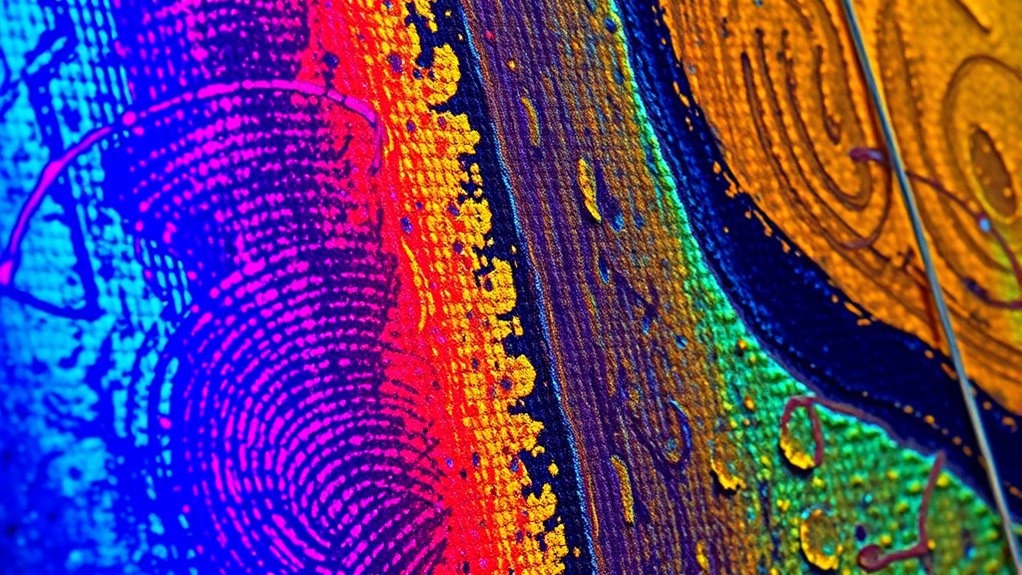
When experts analyze suspected forgeries, they often turn to spectral fingerprinting to uncover hidden clues that reveal deception. By comparing spectral data with known historical context and artistic techniques, they identify inconsistencies. For example, a painting attributed to a Renaissance master may contain pigments unavailable during that period, exposing a forgery. Spectral analysis reveals variations in pigment composition, brushwork, and layering that don’t align with authentic works. These case studies demonstrate how spectral fingerprints uncover deception by exposing subtle differences in materials and methods. Understanding these details helps confirm authenticity or detect fraud, making spectral analysis a essential tool in art history and forensic investigations. Spectral fingerprinting plays a crucial role in revealing the authenticity of artworks by analyzing their material composition.
Advantages of Non-Invasive Testing for Art Preservation

Non-invasive testing helps you preserve artwork integrity by analyzing pieces without causing damage. It allows for rapid assessment, so you can make quick decisions about conservation efforts. This approach keeps masterpieces safe while providing valuable insights efficiently. Utilizing advanced light technology, such as spectral imaging, enables detailed examination of surface and subsurface features without physical contact.
Preserves Artwork Integrity
Because it doesn’t require physical contact or sample removal, non-invasive testing methods help preserve the artwork’s original condition. This approach maintains the integrity of the piece, ensuring its longevity. Here are three key ways it does so: 1. Maintains Color Consistency: Non-invasive techniques prevent damage that could alter or fade colors over time. 2. Ensures Accurate Lighting Calibration: Proper lighting settings protect the artwork from exposure that might cause deterioration. 3. Avoids Physical Damage: No need for sampling or direct contact, reducing the risk of scratches, tears, or other harm. Additionally, employing advanced spectral fingerprinting methods allows for precise identification of pigments without harm to the artwork.
Enables Rapid Analysis
One of the key advantages of non-invasive testing methods is their ability to provide rapid analysis of artworks. With advanced light analysis techniques, you can quickly gather detailed spectral data without damaging the piece. This allows for immediate assessments of color calibration, ensuring accurate representation of the original hues. High spectral resolution enables you to distinguish subtle differences between pigments, speeding up identification processes. Instead of lengthy sample preparation or invasive procedures, you get instant insights into the artwork’s composition. This rapid feedback is essential for decision-making during conservation or authentication efforts. Overall, non-invasive light analysis methods streamline the process, saving time while preserving the artwork’s integrity and providing reliable, high-quality data swiftly.
Limitations and Challenges in Spectral Art Examination
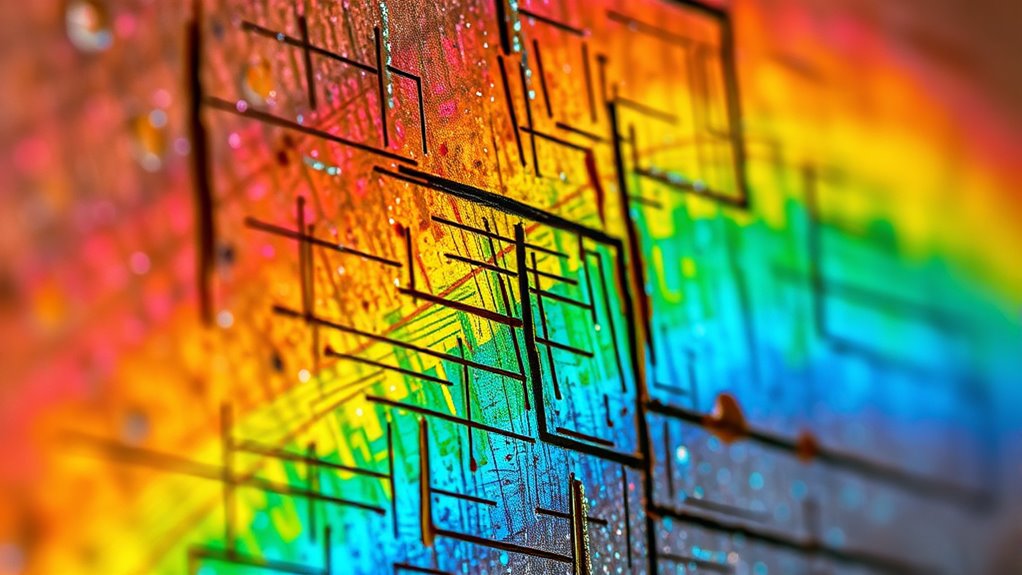
While spectral techniques offer valuable insights into art analysis, they also face significant limitations and challenges. First, interpreting spectral data can be complex, as subtle variations in a digital image may lead to misidentification of materials. Second, these methods often require expensive equipment and specialized expertise, limiting accessibility. Third, ethical considerations arise when analyzing sensitive or stolen artworks, where intrusive testing might damage the piece or compromise provenance. Additionally, spectral analysis may struggle with modern forgeries that mimic authentic materials. You need to balance technological capabilities with the potential risks, ensuring that the examination respects the artwork’s integrity while providing accurate results. Overcoming these challenges requires ongoing research, careful application, and ethical responsibility.
Integrating Spectral Data With Other Authentication Methods
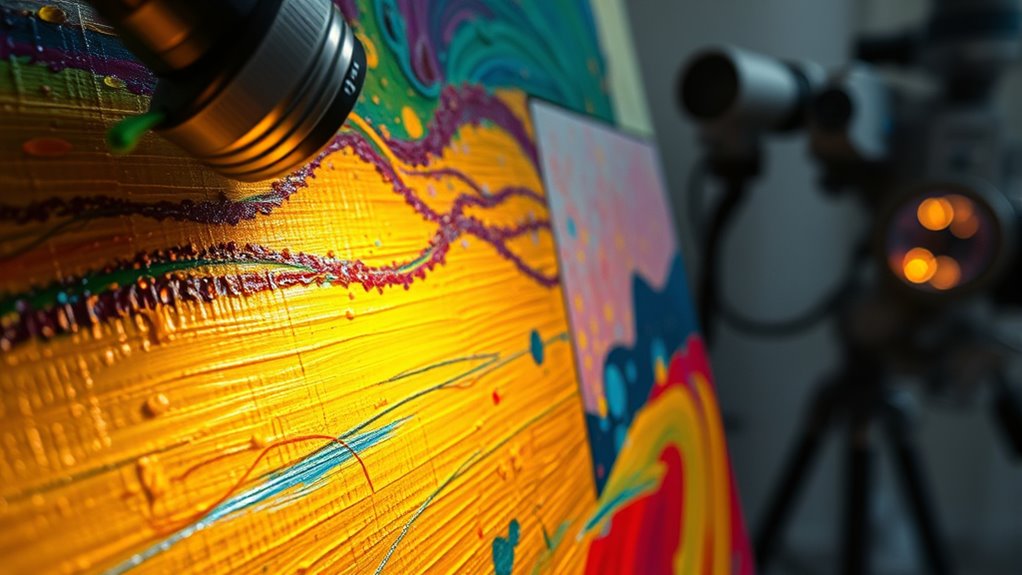
Integrating spectral data with other authentication methods enhances the reliability of art verification by combining multiple lines of evidence. Historically, art experts relied on provenance, stylistic analysis, and expert opinion, but technological advances now allow for more objective assessments. Spectral analysis provides detailed information about pigments and materials, complementing these traditional methods. Ethical considerations come into play when handling sensitive data or when the findings impact an artwork’s value and ownership. Combining spectral data with techniques like X-ray imaging or dendrochronology ensures a thorough evaluation, reducing the risk of misidentification. This integrated approach respects the historical context of each piece, acknowledging its provenance while leveraging scientific insights. Overall, it strengthens confidence in authentication processes and promotes transparency within the art world.
Future Developments in Light-Based Art Analysis
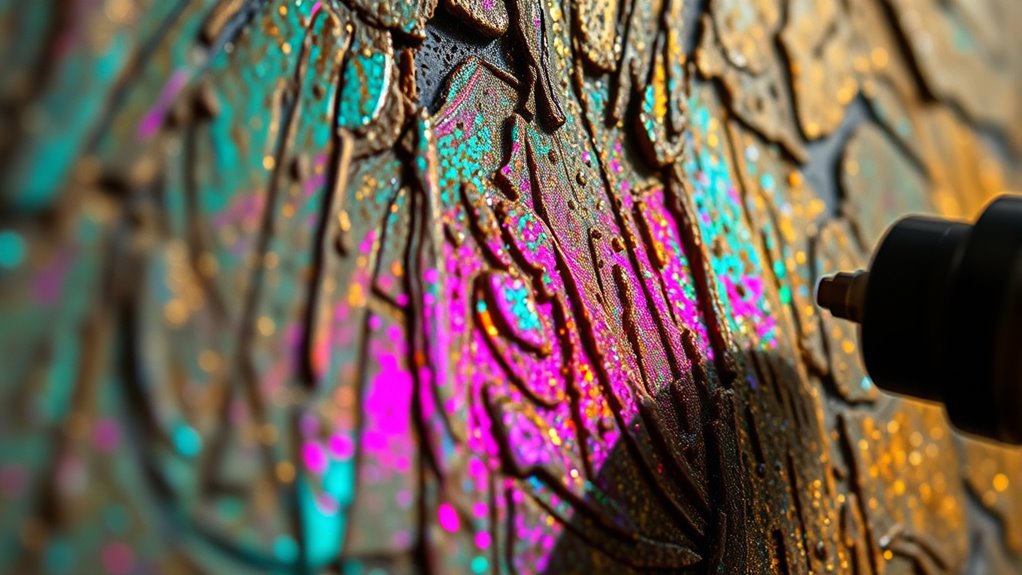
Advances in light-based art analysis are poised to revolutionize how you authenticate and study artworks. Future developments will harness digital imaging to capture detailed spectral data quickly and non-invasively. Expect improvements in conservation techniques, enabling precise identification of pigments and materials without damaging the piece. Innovations such as real-time spectral mapping will allow you to analyze artworks in situ, saving time and resources. Additionally, machine learning algorithms will interpret complex spectral fingerprints, providing faster, more accurate authentication. These advancements will not only enhance the reliability of your assessments but also deepen your understanding of an artwork’s history and condition. As technology evolves, light-based analysis will become an indispensable part of art conservation and authentication efforts worldwide.
The Impact of Spectral Fingerprints on the Art World
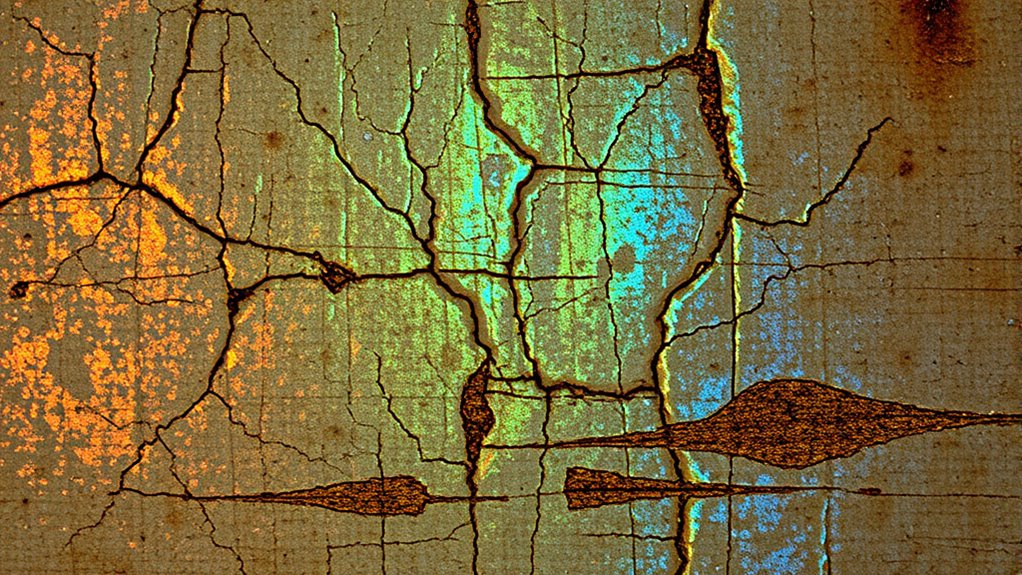
Spectral fingerprints are transforming the art world by providing precise, non-invasive methods to authenticate and analyze artworks. Historically, these techniques mark a significant shift from traditional, invasive testing to safer, more accurate approaches. They help verify a painting’s origin, identify forgeries, and reveal hidden layers without damaging the piece. This technological advancement impacts the market by increasing confidence in provenance, reducing forgeries, and streamlining authentication processes. As a result, artworks can command higher prices, and collectors gain greater trust. Museums and galleries also benefit by preserving integrity and authenticity. Overall, spectral fingerprints are reshaping how art is valued, bought, and protected, making the art world more transparent and secure for everyone involved.
Frequently Asked Questions
Can Spectral Analysis Detect Hidden or Underpainted Artworks Beneath the Surface?
You can use spectral analysis to detect hidden or underpainted artworks beneath the surface. Infrared reflectography is especially effective for underlayer detection, revealing sketches or previous compositions not visible to the naked eye. By analyzing how light interacts with different materials, you can uncover hidden features, giving you valuable insights into a painting’s history and techniques. This method helps authenticate artworks and understand their creative process more deeply.
How Long Does a Typical Spectral Fingerprint Analysis Take per Painting?
You’re curious about how long a typical spectral fingerprint analysis takes per painting. The analysis duration varies depending on the artwork’s complexity, but generally, it takes anywhere from a few minutes to a couple of hours. Spectral precision is essential, ensuring detailed results. You’ll find that advanced equipment speeds up the process while maintaining accuracy, allowing for efficient authentication without compromising the quality of the spectral fingerprint.
Are There Specific Pigments That Are More Challenging to Analyze With Light-Based Methods?
You might think all pigments are equally easy to analyze, but organic and metallic pigments pose unique challenges. Organic pigments often have complex light absorption patterns, making their spectral fingerprints harder to interpret. Metallic pigments can produce reflective effects that complicate analysis. Despite these difficulties, advanced light-based methods are improving, helping you authenticate paintings more accurately even when dealing with tricky organic or metallic pigments.
How Costly Is Implementing Spectral Fingerprinting Technology for Art Authentication?
You’ll find that implementing spectral fingerprinting technology can be quite costly. The cost comparison shows significant equipment expenses, especially for high-resolution spectrometers and specialized light sources. While the initial investment is substantial, it offers precise authentication capabilities that can save money long-term by preventing forgeries. However, smaller galleries or individual collectors might find these expenses steep, making it less accessible without institutional funding or partnerships.
Can Spectral Analysis Be Used to Date a Painting’s Creation Year Accurately?
Like a detective peeling back layers of history, spectral analysis can help date a painting, but it’s not foolproof. You can’t rely solely on this method because of geographical variations and pigment aging, which affect how pigments change over time. These factors make it tricky to pinpoint the exact creation year. Still, spectral analysis offers valuable clues, providing a scientific edge in understanding a painting’s age.
Conclusion
Think of spectral fingerprints as a secret code hidden within each masterpiece, waiting for you to unveil its story. By shining light on these artworks, you become a detective revealing truths that the naked eye can’t see. As you master this technique, you’ll navigate the labyrinth of forgery and authenticity, turning every painting into a chapter of history. Embrace this luminous journey—your key to preserving art’s true soul.
